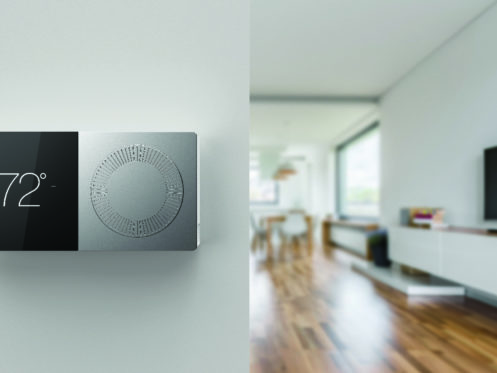Updated January 18, 2024
When it comes to household comfort and functionality, thermostat placement is far more impactful than most homeowners think. If you’ve recently purchased a new, modern thermostat, you need to be deliberate and strategic about where you choose to set it up. Alternatively, if you’re having trouble keeping your home consistently comfortable, moving your thermostat to a different area may make a significant difference.
Modern “smart” thermostats do their job by regularly gauging the temperature in their general vicinity. Once you’ve programmed your preferred household temperature, your thermostat will use that information as well as your tendencies to determine if your living space is hotter or colder than it should be. Then, if it thinks you need cold or warm air circulated, it will relay that message to your HVAC system. However, if your thermostat is somewhere that doesn’t provide an accurate picture of your home’s climate, the instructions that it passes to your heating and cooling appliances will be incorrect. This is what’s referred to as a “ghost reading.”
When choosing where to place your thermostat, the primary goal should be to avoid regular ghost readings. That means finding somewhere that features temperatures as near to the average climate of your home as possible. You need to avoid places with high, low, or fluctuating temperatures. If you follow these helpful tips, you should be able to maintain consistent home comfort, prevent wasted energy, and keep your HVAC appliances running only when needed.
1. Measure the Distance From the Floor
Wherever you decide to set up your thermostat, you should always make a point to measure the distance from the floor. The thermostat should always be within the range of 50 to 62 inches up the wall. It’s important to remember that hot air naturally rises, and cold air naturally sinks. So, if you place the thermostat any higher than 62 inches from the floor, its temperature readings will almost certainly be higher than they should be. Alternatively, anywhere lower than 50 inches and the readings will be colder. Either way, you’ll be dealing with inconsistent readings, and your heating and cooling appliances will frequently be running at the wrong times.
2. Keep the Thermostat Out of Direct Sunlight
While this may seem like an obvious tip, placing a thermostat in the path of direct sunlight is a mistake that numerous homeowners make. Doing so will inevitably lead to hot ghost readings, which will result in the household AC unit being overworked and the home becoming uncomfortably cold. When this mistake occurs, it’s usually because someone installed their thermostat during the evening or on a cloudy day and failed to consider where sunlight would hit. When you’re setting up your thermostat, be sure to consider where the sun’s rays will be shining on a bright summer day.
3. Choose a Spot Near the Center of Your Home
If you want to keep your household’s climate as even and consistent as possible, you should put your thermostat near the center of your home. For one, the center of your house is likely accessible to every member of the family, which will come in handy whenever someone needs to make manual adjustments. More importantly, this area of your home tends to feature temperatures very similar to the majority of the living space.
4. Avoid the Kitchen
Did you know that in most households, the kitchen tends to be one of the hottest rooms? You may not notice or realize it, but whenever you use your stove or oven, the temperature of your kitchen rises significantly. So, if you use those appliances with any sort of regularity, installing your thermostat in the kitchen would be an unwise choice. If you do, the temperature readings will commonly be too high, and your air conditioner will end up working far harder than it should. Plus, with all of that unnecessary cool air circulating, you’ll find that your home is frequently chilly.
5. Consider Your Family’s Favorite Room
This is a good option to consider if there’s an area in your home where you spend the majority of your time. If, for example, you and your family spend almost all of your free time relaxing in the living room, it may be an effective choice to install your thermostat there. That way, its temperature readings will usually be pulled from the room that you’re occupying, which means your HVAC appliances will consistently be keeping that room right at your preferred temperature. That said, this method won’t necessarily lead to even and consistent temperatures throughout the house. Of course, if it turns out that your favorite room is located near the center of the home, there’s a good chance that room will reach the ideal temperature as well.
6. Stay Away From Windows and Doors
Usually, areas of your home near windows and exterior doorways will be prone to regular temperature fluctuations. For example, if your thermostat is located near your front door, it will get hit with a gust of air from outside every time the door opens. Unless your home is the same temperature as the air outside, that will lead to ghost readings. Alternatively, if your thermostat is placed near a window, any drafts that come through the glass will mess with the temperature readings. If the window happens to be suffering from any air leaks, the ghost readings will most likely be even more frequent and inaccurate.
7. Stay Away From Air Vents
Your air vents are spread throughout your home, and they’re the means that your heating and cooling systems use to distribute air. So, that means that warm and cold air will be regularly exiting from the vents whenever those appliances are running. If your thermostat is located above or below one of those vents, its temperature gauge will be thrown off on a regular basis. It’ll be hard to find an area without any nearby vents, but you should be fine as long as you keep the thermostat at least a few feet away from any of them.
8. Consider Which Floor You’re Choosing for Your Thermostat
If you have a multi-story home, you should be strategic about which floor you’re choosing for your thermostat location. If your home has two stories, there’s a good chance that the rising heat will result in the second floor being much warmer than the first. In that case, putting the thermostat on the ground level would likely be your best bet. Alternatively, if you live in a three-story home, the second floor is probably the ideal choice. The third floor will be especially warm, and the first floor may be pretty chilly, but the middle floor should offer a good happy medium.




